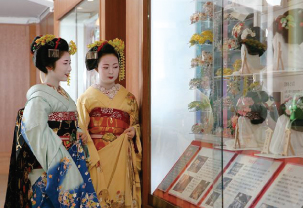Geisha encounters
Course for discovering traditional
arts of Kyoto
Start!
1Keihan Line/Subway Tozai Line Sanjo Sta.
2Seseragimichi path
3Tatsumibashi bridge

This is a popular photo spot to show that you have been to Gion. Wheelchair users can get a great view of the river from the bridge. And, if you are lucky, you may seem some carp swimming in the river. Cross the bridge and move into the narrow lane, continue to the end and then turn left.
4Yasaka Hall : Gion Corner

The formal name of this temple is Rengeoin Temple. Shogun Kiyomori built it in the Heian period, and gifted it to Goshirakawahouou (ex-emperor a nd later a monk).
5Kennin-ji Temple

This temple was established by Eisaizenji upon returning to Japan from Sung China in the Muromachi period (1333-1573). It was the first Zen temple in Kyoto. Eisai is famous for introducing tea and the preparation method to Japan.
| Rokudo Chinno-ji Temple |

Known affectionately as "Rokudo-san". This temple belongs to t he Kenni-ji school of the Rinzai sect. The well here is well known as the one that Ono Takamura used to access the underworld.
6Miyagawa-cho

One street east of Kawabata-dori, this little lane does not get many tourists stepping into to it and it is narrower than Hanamikoji, but, come dusk, the geisha and maiko of M iyagawa-cho tread to and frot hrough h ere, a dding a real geisha quarter touch.
7Minamiza Theater

Pop out on to Kawabata-dori from Miyagawa-cho, and go north until you reach theMinamiza Theater. Back in Edo times, some seven theaters had licenses to operate in this area, but now just the Minamiza Theater remains.
And, it stands across from the No. 2 entrance to the Keihan Gion Shijo Station.
8Keihan Gion Shijo Sta.

Goal!